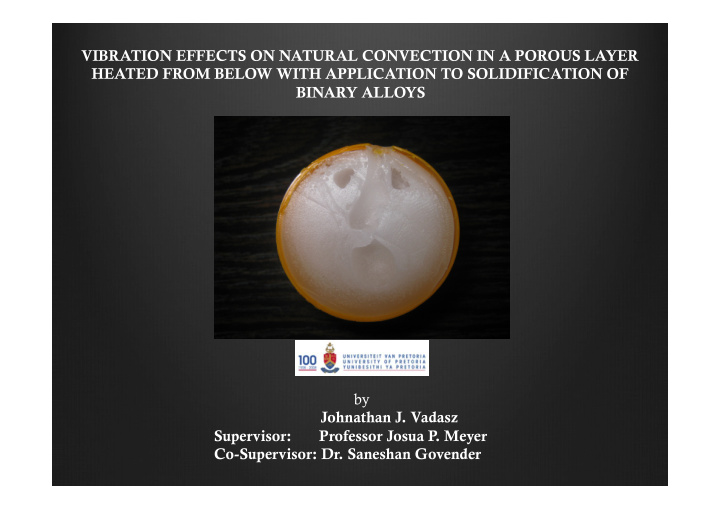



VIBRATION EFFECTS ON NATURAL CONVECTION IN A POROUS LAYER HEATED FROM BELOW WITH APPLICATION TO SOLIDIFICATION OF BINARY ALLOYS by Johnathan J. Vadasz Supervisor: Professor Josua P . Meyer Co-Supervisor: Dr. Saneshan Govender
Outline • Purpose of study • Experimental method and results • Theoretical method of solution • Theoretical results and discussion • Conclusions • Recommendations • Acknowledgments
Purpose of study Identifying regimes of enhancement in heat transfer is one of the aims and therefore the purpose of this study is to investigate the effect of heat transfer alone on a porous layer (representing the mushy layer in the solidification process) subject to vibration and particularly identifying thermal resonance occurrence and whether the thermal resonance may or may not enhance the heat transfer. A sufficiently wide parameter regime is to be considered, yet the work is to be undertaken via analytical or combined analytical-numerical methods in order to be able to draw qualitative as well as quantitative conclusions.
Experimental method and results ! ! Figure 1: Picture and schematic of experimental set-up showing the thermal bath, vibration exciter, test sample location, and cantilever system attached to the rigid frame.
Table 1: Samples showing the relationship between the enhancement ratio Gr v / Gr and the average density of solidified paraffin wax. Every sample is the average of five samples. Table 2: Measured mass of solidified paraffin wax at different times under no vibration for five samples.
Table 3: Measured mass of solidified paraffin wax at different times under a vibration frequency of 100 Hz for five samples.
Figure 2: Mass of solid paraffin wax formed versus time for no vibration and vibration frequency of 100 Hz for five samples of each.
Figure 3: Average mass of solid paraffin wax formed versus time for no vibration and vibration frequency of 100 Hz.
5 minutes ! 20 minutes ! Final solidification time !
Theoretical method of solution Figure 4: A two-dimensional rectangular domain heated from below (or cooled from above) subject to accelerations due to gravity and imposed vibrations.
Governing Equations:
Theoretical results and discussion
X versus time ω = 6.5 R = 25 3 2 1 0 X -1 -2 -3 60 80 100 120 140 160 180 200 220 t X versus Y ω = 6.5 R = 25 3 2 1 0 Y -1 -2 -3 -3 -2 -1 0 1 2 3 X
3 2.5 λ λ λ λ ω = 0 ; δ = 0 1 2 3 4 ω = 6.5 ; δ = 1 Nu 2 1.5 1 1.5 0.5 1 0 20 40 60 80 100 0 R λ i -0.5 -1 -1.5 -2 0 5 10 15 20 25 30 35 40 R
Conclusions • All anticipated regimes of natural convection were indeed obtained, including periodic, quasi-periodic, and chaotic (weak-turbulent) regimes. • The anticipated nonlinear thermal resonances do not affect substantially the average heat transfer by convection because the solutions seem to behave quite symmetrically around the average values and therefore the averaging process removes any such instantaneous large amplitude effects. • The combined heat and mass transfer by convection is therefore the remaining reason for the improvement observed experimentally in the solidification process subject to vibrations. • With hindsight one may be able to anticipate that one of the mass transfer mechanisms, namely the freckles formation, and the consequent variation of solid fraction (or equivalently the porosity) is the probable cause for the improvement in the solidification process when subjected to vibrations. This mechanism is expected to depend strongly on convection heat transfer as well as convection mass transfer in the porous medium (mushy layer).
Recommendations Based on the conclusions a clear course of action can be recommended in terms of follow-up studies having the objective of fully understanding the causes behind the experimentally established improvement of the properties of the cast in the solidification process. It seems that a combination of heat and mass transfer processes might provide the explanation for such improvement. Therefore a substantial further development of the model developed in the present study to include mass transfer is recommended as the next step. While models of heat and mass transfer within a mushy layer were derived previously and were presented in the literature survey, they have the limitation of being applied for a very narrow range of thermal and solute Rayleigh numbers, i.e. very close to the critical values of these Rayleigh numbers, making the results and conclusions quite limited. On the other hand, other attempts focused on full numerical simulation which suffers from a too large parameter space, i.e. too large number of parameters and consequently a voluminous number of results and graphs that are difficult to analyse. Extending the model proposed in the present study to include mass transfer and particularly to model the variation of the porosity (or its equivalent solid fraction) in time as well as in space and consequently the freckles formation is a very challenging and possibly extremely time consuming task, but nevertheless it is needed as the next step recommended based on the present study conclusions.
Acknowledgments I would like to thank Professor Josua Meyer as my supervisor for his support with conference attendance and experimental work funding as well as constant guidance with journal and conference publications. I would also like to thank Professor Saneshan Govender as my co-supervisor for assistance in my PhD thesis research. Specifically for supplying me with some Journal paper publications and other relevant literature to my research. I would like to thank Prof. G. Ziskind and Prof. A. Levi whom had a lot of input with the experimental part and supplied the equipment and facilities.
Thank you Questions???
Recommend
More recommend